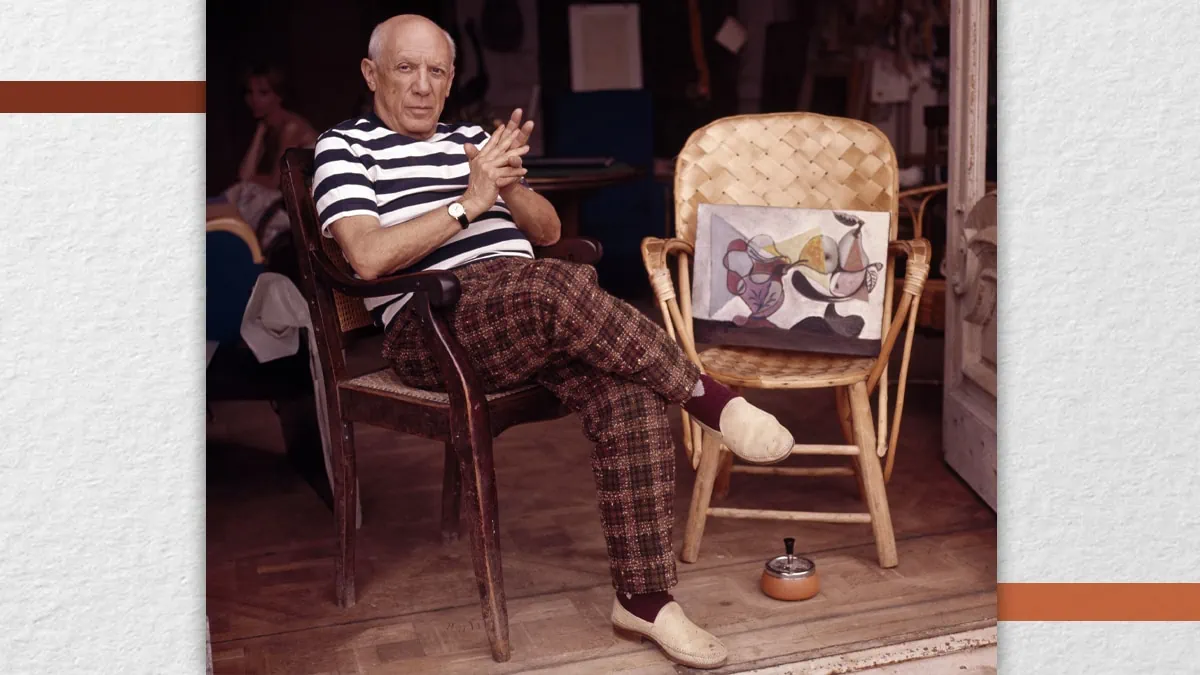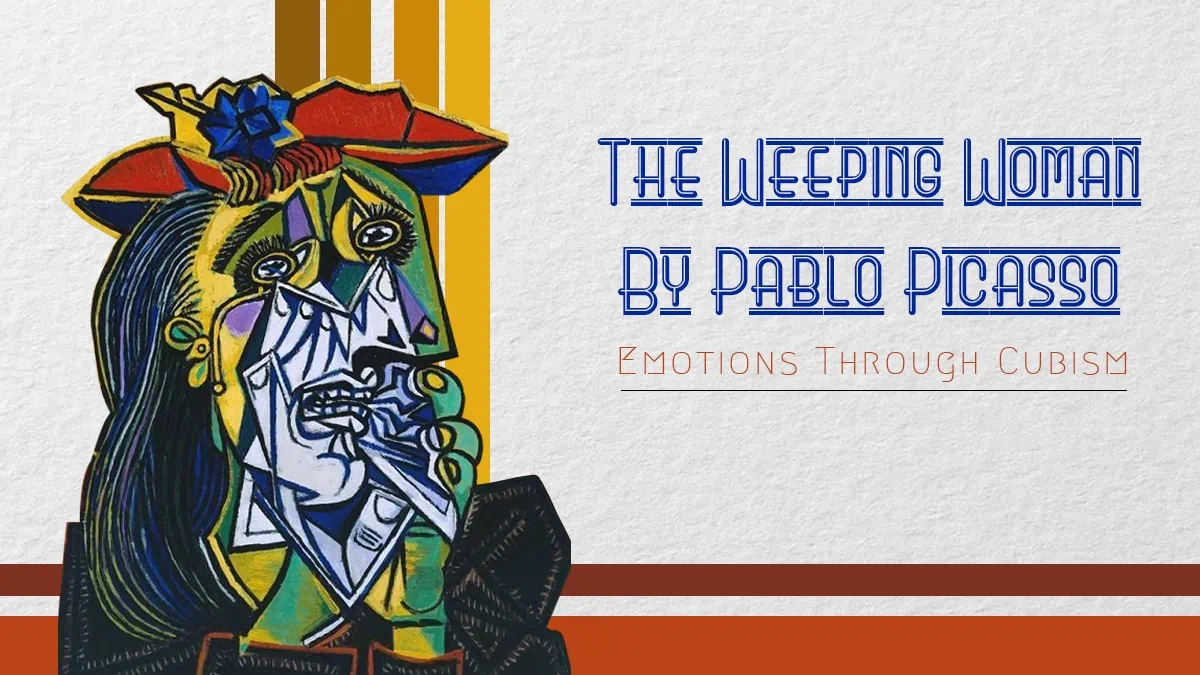Oh, this is pain, this is anguish! I faint, I fail. Now my body thaws; I am unsealed, I am incandescent. – Virginia Woolf
I personally thought that this moving quote by the great feminist author would best represent The Weeping Woman by Pablo Picasso!
We would think it is impossible for an edgy and rigid style like cubism to express emotion.
But here we have, the most famous cubist artist himself, who has created his weeping lady with a lot depicted in the painting!
Did you know that this is not the only weeping woman painting that Picasso has created?
There is a whole series of paintings from 1937 that display the crying lady in Picasso’s style, but why is this one so important?
And, has a thought struck you by this time?
Who is this crying lady and why did Pablo Picasso choose to create a series of paintings of The Weeping Woman?
Well, I have assembled information from my research that will help you answer these questions and more!
There is something about the despondency of a woman, as phrased by Virginia Woolf above, the anguish of it all.
But here we see The Weeping Woman from a man’s perspective, so we also have a chance to explore the male gaze here.
Before we get into the painting, let us briefly look at the artist himself, Pablo Picasso, whose life has been an inspiration to many artists!
Table of contents
A Little About the Artist: Picasso

Pablo Ruiz Picasso, was born into an artist family with his father being a professor of drawing.
He began his artistic education from a very young age of 7, and he was unstoppable from there on.
It is even believed that his father resigned from his role, being immediately humbled by his son’s talent.
A true rebel at heart, Picasso was not like other artists and had his own style which was far away from traditional techniques.
His art is also known by several periods, like The Old Guitarist from the blue period and Les Demoiselles d’Avignon from his African influence.
Picasso spent every phase of his lifetime creating art that reflects his psyche and what he perceives through his eye.
And that way, he managed to create over 50,000 paintings, varying in style, genre and technique and created history!
The Weeping Child by Picasso was painted during the Spanish Civil War period which covered from 1936 to 1939.
With no further ado let us get into what inspired the artist to paint The Weeping Woman.
Furthermore let us dig into who exactly The Weeping Woman by Picasso is.
Into the Socio-Historical Context

The Weeping Woman by Picasso was created in the year 1937, and it was part of a series.
The series consisted of four paintings that depicted “the crying woman”.
Now residing in the Tate Modern museum in London, this particular weeping woman painting got a lot of attention!
Fun fact: Did you know that The Weeping Woman painting in discussion here was inspired from Picasso’s infamous Guernica?
Yes, one look at the painting and the name together clearly suggests the theme is around despondency and misery.
Guernica itself was a work that made a protesting statement through art, against the aerial bombing on Guernica town by Hitler!.
Through The Weeping Woman, Pablo Picasso wanted to bring focus to the after effects of the war.
Therefore, this painting takes inspiration from a part of Guernica.
A woman holding the dead body of her baby in Guernica and struck with immense turmoil!
Through his attempts of trying to bring out the right depiction of the painting, he created four such crying woman paintings.
More interestingly, Picasso’s muse was a photographer and artist, Dora Maar, who was allegedly intimate with too.
Picasso had a lot of explaining to do on why he had depicted his muse in such a tortured manner.
To this he replied, it was not a depiction of torture from a perspective of pleasure, but of just acknowledging a woman who was in torment!
Furthermore he explained that he always perceived her to be a “weeping woman” because of Maar’s facial features.
He also stressed upon the importance of showing this torment because “women are suffering machines”.
What is interesting is that there have been several renditions and interpretations of The Weeping Woman by Picasso, including Maar’s.
Suggested Read: Ivan the Terrible and His Son Painting Explained!
Formal Analysis of Picasso’s Weeping Woman
A painting that reflects universal suffering and deep grief, The Weeping Woman by Picasso has so many layers to it, not just metaphorically.
Let us now get into the formal analysis of the painting, where we shall focus on the subject, the hues used, and a little bit on the technique too!
1. The Subject

By now we know the subject was inspired by Pablo Picasso’s muse and alleged mistress, Dora Maar.
The brilliance of the maestro lies in actually bringing a reflection of Maar’s face in The Weeping Woman.
If you look closely, it is impossible not to see those forlorn features of the woman in context.
The subject is extremely fragmented, which is incredibly highlighted using the cubism style, which he excels in.
Each and every element added to this subject elevates the theme.
The tears shown flowing down, the position of the head tilted upwards, the hands holding onto what seems like a handkerchief.
Her eyes, although open, show distress and everything encapsulates her grief and misery through the painting.
Although the genre is cubism, there are places where Picasso has depicted as flowing— the tears and even her hair.
It would leave one spellbound on how someone can show so much grace, movement and emotions through a style like cubism!
Picasso was also smart enough to add certain features of Dora Maar into The Weeping Woman; for example, the way her hair sits.
Additionally, our subject here is very fashionably clothed, with a red and blue hat and yellow flower adorning it.
Because it’s highly fragmented, the painting brings our focus on the face of the crying woman and her hands holding the handkerchief.
So while the crying woman is in clear agony, she is also depicted in utmost style!
Suggested read: Henri’s Woman with a Hat: What’s the Controversy Behind It?
2. Color and Shades

One look at the painting and our visual senses are overwhelmed with a splash of colors.
If anyone has experimented with colors, no one quite done it like Picasso.
In The Weeping Woman by Picasso there are many colors included like reds, yellows, greens, blacks, browns and purples.
The only monochrome in art you see here is the part where the handkerchief is shown with grayish and off-white colors.
But other than that Picasso has definitely had fun curating this art with the primary and secondary colors.
He has also used these hues to create texture to the painting wherever required and enhanced the cubism features.
To Conclude: The Weeping Woman, an Inspiration

The Weeping Woman by Picasso came at a time of war and chaos and represented the misery carried by war victims.
It was not just a painting with a political statement but also a masterpiece from which many artists yielded inspiration from!
Like I said, there is a plethora of art made by Picasso that was gifted to this world.
Therefore, one cannot gather the artist’s technique and style with just one painting from a particular period.
That is why I would suggest that you indulge in paintings by Picasso that will leave you wanting more from his world!
If possible, I would definitely urge you to witness some of his paintings in person and get swept away by its brilliance.
Until then, I will see you in the next one.
Frequently Asked Questions
Pablo Picasso’s The Weeping Woman is inspired from a part of Picasso’s Guernica, where a woman holds her dead baby in her hands and cries in agony. The painting expresses the utmost grief of a woman from Picasso’s perspective.
Yes, this version in context was made part of Picasso’s “crying woman” series. Apart from this particular painting, there are three other crying woman paintings in the series. It is said that Picasso attempted to paint more “weeping woman” through the years.
Pablo Picasso’s alleged mistress and muse, Dora Maar was this painting’s inspiration for Picasso. In fact, if you look closely there are several features of Maar’s that Picasso has incorporated in the painting.





